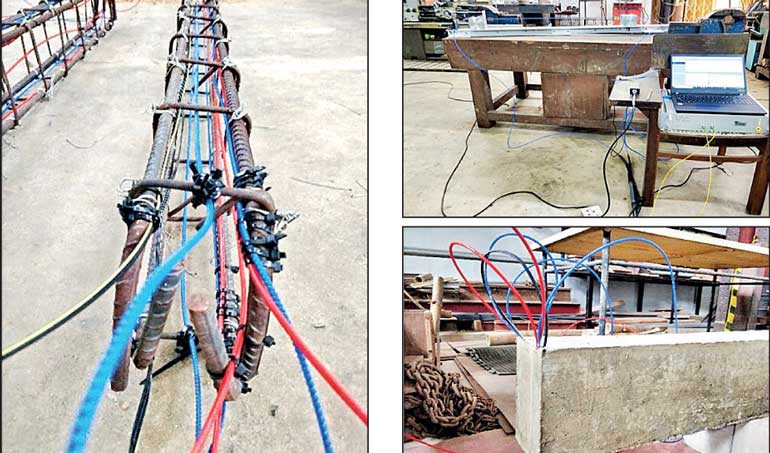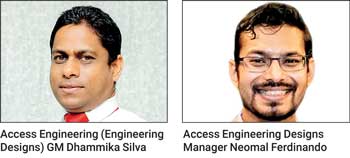Thursday Apr 17, 2025
Thursday Apr 17, 2025
Tuesday, 7 November 2023 00:37 - - {{hitsCtrl.values.hits}}

 ‘The Engineer UK’ has shortlisted the research initiative conducted by the University of Cambridge (Cambridge Centre for Smart Infrastructure and Construction), University of Moratuwa, University of Oxford and Access Engineering PLC (AEL) for the introduction of fibre optic monitoring technology for structural health monitoring.
‘The Engineer UK’ has shortlisted the research initiative conducted by the University of Cambridge (Cambridge Centre for Smart Infrastructure and Construction), University of Moratuwa, University of Oxford and Access Engineering PLC (AEL) for the introduction of fibre optic monitoring technology for structural health monitoring.
Shortlisted under two separate categories; primary category being the ‘Information, Data and Connectivity’ with the secondary category being the ‘Wild Card’, the research initiative was themed ‘Innovative Pre-Straining Tools and BOFDA Technology Assessment: A Transnational Leap in Infrastructure Monitoring’ by The Engineer – Collaborate to Innovate (C2I) United Kingdom.
Fibre optic monitoring technology is a widely used application in Structural Health Monitoring (SHM) due to its immunity to electromagnetic interference and corrosion resistance and the shortlisted research initiative explored the use of Brillouin Optical Frequency Domain Analysis (BOFDA), which is a relatively new fibre optic monitoring technology. An objective of the project was also to address gaps in the current understanding of workmanship factors essential for effective Fibre Optic Monitoring. Collaboration from various industry experts was a key feature throughout every phase of the research and included expertise of fibris Terre Systems GmbH – the equipment supplier from Germany, University of Qatar and WSP UK as well. The monitoring equipment supplied by fibris Terre Systems GmbH proved to be more effective both in terms of cost effectiveness and the application of technology.
Commenting on this recognition Access Engineering’s Engineering Designs General Manager Dhammika Deshapriya Silva said: “Fiber optics technology is used in different sectors for different purposes. Civil and Structural Engineering disciplines have more opportunities to use this technology for its advancements. Detailed investigation of bored pile foundation systems, Structural elements’ health monitoring of buildings and bridges, finding out real-time structural response to dynamic loads, assessment of the structural integrity and early warning systems for Structural and Geotechnical catastrophes are a few aspects of using Fiber optic technology in relation to Civil and Structural Engineering disciplines.”
“As a leader in the Design and construction of infrastructures, buildings and other Civil structures, Access Engineering PLC’s knowledge has upgraded with global best practices, new technologies and the use of state of art software in day-to-day practices. Obtaining fiber optic monitoring technology is one of the great achievements of Access Engineering and is important to Sri Lanka as well. Our initial intention is to use fiber optic technology to investigate the pile foundation systems, axial shortening and structural response of the heavily loaded columns of a high-rise building. We have successfully completed the model test in laboratory conditions with the help of the University of Moratuwa and currently, we are ready to deploy this technology under real conditions.”
Designs Manager Neomal Ferdinando said: “Combined with artificial intelligence this technology is the gateway for futuristic ‘Smart Structures’ which can trigger a warning in the event the structure or a critical component becomes unstable. It will also provide vital information which can shape future designs and guidelines.”
Access Engineering as Sri Lanka’s foremost civil engineering and construction enterprise and the leader in value engineering, undertook this study as a brainchild of its own innovation hub; ‘Idea Nest’, the objective of which is to nurture potential ideas to become useful applications in civil and mechanical engineering disciplines and to enhance the much-needed innovation culture our country requires.
Gowshikan Arulananthan was the first Masters student who benefitted from this initiative spearheaded by Idea Nest as he was handpicked to continue this topic as part of a PhD at the University of Wisconsin – Madison, USA.
Access Engineering has a long history of introducing new and unconventional construction techniques to the local industry.
Discover Kapruka, the leading online shopping platform in Sri Lanka, where you can conveniently send Gifts and Flowers to your loved ones for any event including Valentine ’s Day. Explore a wide range of popular Shopping Categories on Kapruka, including Toys, Groceries, Electronics, Birthday Cakes, Fruits, Chocolates, Flower Bouquets, Clothing, Watches, Lingerie, Gift Sets and Jewellery. Also if you’re interested in selling with Kapruka, Partner Central by Kapruka is the best solution to start with. Moreover, through Kapruka Global Shop, you can also enjoy the convenience of purchasing products from renowned platforms like Amazon and eBay and have them delivered to Sri Lanka.
Discover Kapruka, the leading online shopping platform in Sri Lanka, where you can conveniently send Gifts and Flowers to your loved ones for any event including Valentine ’s Day. Explore a wide range of popular Shopping Categories on Kapruka, including Toys, Groceries, Electronics, Birthday Cakes, Fruits, Chocolates, Flower Bouquets, Clothing, Watches, Lingerie, Gift Sets and Jewellery. Also if you’re interested in selling with Kapruka, Partner Central by Kapruka is the best solution to start with. Moreover, through Kapruka Global Shop, you can also enjoy the convenience of purchasing products from renowned platforms like Amazon and eBay and have them delivered to Sri Lanka.